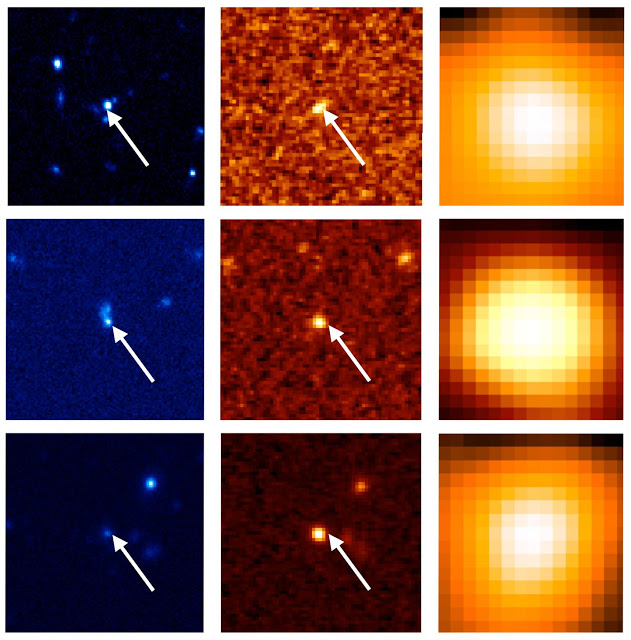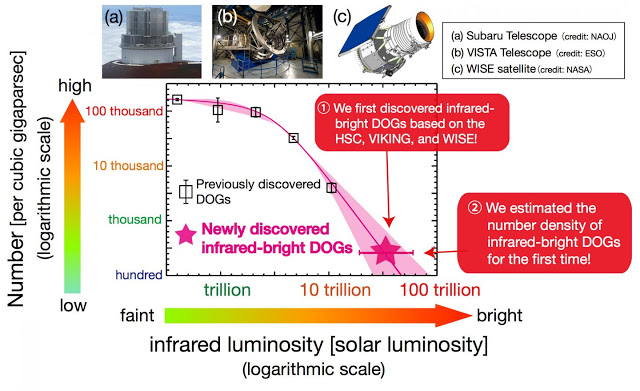| Online: | |
| Visits: | |
| Stories: |

| Story Views | |
| Now: | |
| Last Hour: | |
| Last 24 Hours: | |
| Total: | |
Discovering Dust-Obscured Active Galaxies As They Grow

Credit: Ehime University/NAOJ/NASA/ESO
The group of researchers, lead by Dr. Yoshiki Toba (Ehime University), focused on the Dust Obscured Galaxies (DOGs) as a key population to tackle the mystery of the co-evolution of galaxies and black holes. DOGs are very faint in visible light, because of the large quantity of obscuring dust, but are bright in the infrared. The brightest infrared DOGs in particular are expected to harbor the most actively growing black hole. In addition, most DOGs are seen in the epoch when the star formation activity of galaxies reached its peak, 8-10 billion years ago. Thus both DOGs and their black holes are rapidly growing, at an early phase of their co-evolution. However, since DOGs are rare and are hidden behind significant amount of dust, previous visible light surveys have found very few such objects.
Hyper Suprime-Cam (HSC) is a new instrument installed on the 8.2 meter Subaru Telescope in 2012. It is a wide-field camera with a field of view nine times the size of the full moon. An ambitious legacy survey with HSC started in March 2014 as a “Subaru strategic program (Note 1)”; total of 300 nights have been allocated for a five year period. The Subaru strategic program with HSC started to deliver large quantities of excellent imaging data.
The research team selected DOGs from early data from the HSC Subaru Strategic Program (SSP). DOGs are thousand times brighter in the infrared than the optical and the team selected their targets using the HSC and NASA’s Wide-field Infrared Survey Explorer (WISE: Note 2). They also utilized the data from the VISTA Kilo-degree Infrared Galaxy survey (VIKING: Note 3). The all-sky survey data with WISE are crucial to discover spatially rare DOG while the VIKING data are useful to identify the DOGs more precisely.
The number density of DOGs that were newly selected in this study, as a function of infrared luminosity. Data represented by the red star is the HSC result. The research team found that (i) their infrared luminosity exceeds 10 trillion suns, and (ii) their number density is about 300 per cubic gigaparsecs.

Credit: Ehime University/NAOJ/NASA/ESO
In this research, the research team discovered 48 Dust Obscured Galaxies and revealed their statistical properties of infrared luminous DOGs in particular, for the first time.
The first author of the paper Dr. Yoshiki Toba said, “There are no instruments on large telescopes with the sensitivity and field of view of HSC, and hence HSC is unique in its ability to search for DOGs. The HSC survey will cover more than 100 times as much area of the sky as the area used for this study when it is complete, allowing the identification of thousands of DOGs in the near future. We are planning to investigate the detailed properties of DOGs and their central black holes using observations from many telescope.”
Also, Professor Tohru Nagao, second author of the paper, said “The Subaru Strategic Program with HSC has just begun. In the near future, exciting results will be released not only from studies on galaxy evolution, but also from in fields such as solar systems, stars, nearby galaxies, and cosmology.”
Contacts and sources:
Saeko S. Hayashi
National Institutes of Natural Sciences
Source:



